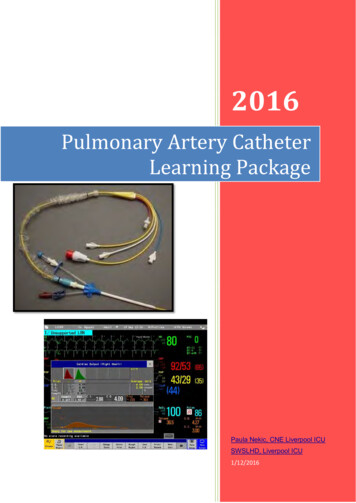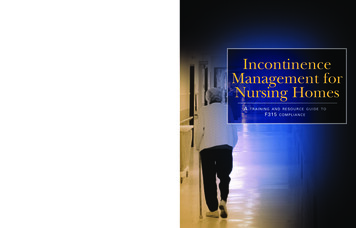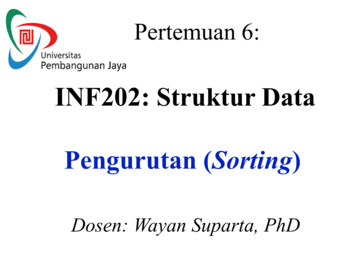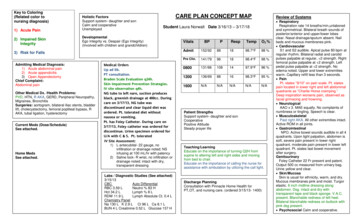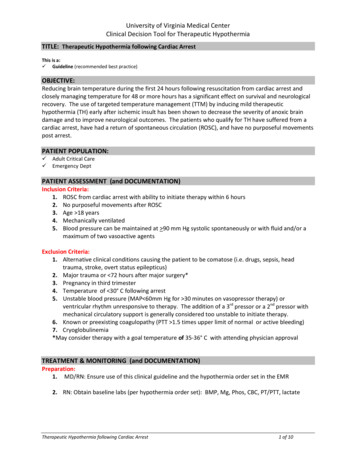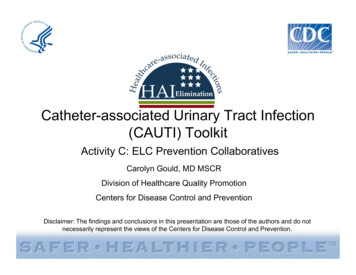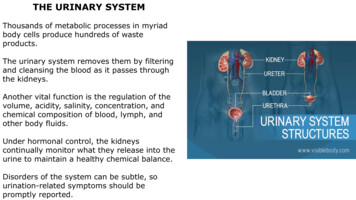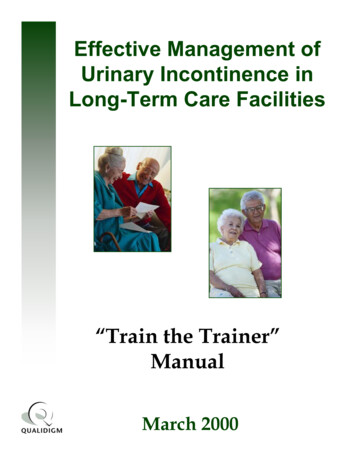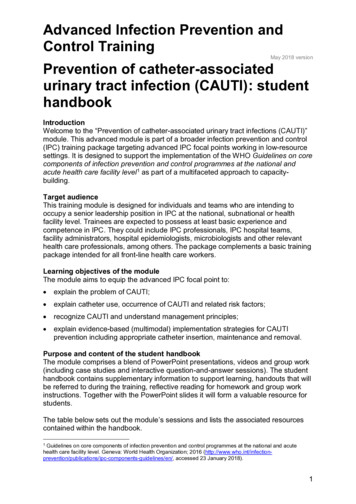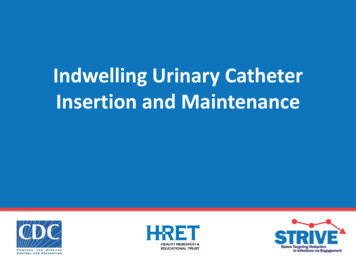
Transcription
Indwelling Urinary CatheterInsertion and Maintenance
PresenterMilisa Manojlovich, PhD, RN, CCRNProfessor of NursingUniversity of MichiganContributions byKristi Felix, RN, BSN, CRRN, CIC, FAPICMadonna Rehabilitation HospitalLinda Greene, RN, MPS, CIC, FAPICUniversity of Rochester, Highland HospitalJennifer Meddings, MD, MScUniversity of MichiganSanjay Saint, MD, MPHUniversity of MichiganBarbara W. Trautner, MD, PhDBaylor College of MedicineKaren Fowler, MPHUniversity of Michigan2
Learning Objectives Describe strategies for aseptic insertion of indwellingurinary catheters Identify approaches to overcome barriers to urinarycatheter aseptic insertion Identify strategies to overcome barriers to urinarycatheter maintenance3
Why is Aseptic Insertion So Important? The rate of catheter use may be rising– About 15-25% of hospitalized patients CAUTI is costly and increases morbidity Bacteria can enter the bladder during insertion– Guidelines have always recommended aseptic insertion ofindwelling urinary catheters(Catheter-associated Urinary Tract Infections (CAUTI), CDC, 2015)4
Components of the CatheterInsertion and Maintenance Bundle(Meddings J, Saint S. Disrupting the life cycle of the urinary catheter. Clin Infect Dis.2011;52(11):1291-3. PMID: 21596672.)5
Use a Standard Indwelling Urinary Catheter Kit Several different types of kits on the market Closed-system catheter insertion kits arerecommended Supplies in each kit are organized by order of use Consider removing individual catheters from stock6
Ensure Proper Insertion Technique Aseptic insertion technique is recommended Many nurses and other clinicians have to relearn“proper” technique– Working environment does not resemble learningenvironment Inserting clinicians should receive competency-basedtraining and be able to demonstrate indwellingcatheter insertion competency– Practices should be observed and monitored in real worldsettings after initial training.7
Categories and Frequencies ofMajor Breaks in SterilityCategoryContamination of sterilefieldContamination of thecatheterFrequency(%)Examples22 (27%) Nurse touched items on sterile field withbare non-sterile hands. Stethoscope/garment/torso touchedsterile field. Patient’s labia closed over the catheterduring insertion and contaminated thecatheter; nurse did not get a new one. Catheter tip touched genitalia beforebeing introduced into urethra.Sterile gloved hand used to swab genitalia(without tongs); same hand used to insertcatheter.25 (31%) Breach of sterile barrier31 (38%) Nurse inserting catheter ripped her sterilegloves, did not get new ones.(Manojlovich M, Infect Control Hosp Epidemiol, 2016; Lo E, Infect Control Hosp Epidemiol 2014; Carter EJ,Infect Control Hosp Epidemiol, 2016)8
Both Technical and Socio-AdaptiveStrategies are Needed Technical– Provide competency-based training for all staff inserting catheters– Confirm availability of supplies needed for aseptic insertion– Ensure appropriate hand hygiene and personal protective equipment(PPE) use– Use checklists to help streamline insertions and assure they are doneaseptically– Conduct routine audits and provide timely feedback on asepticinsertion practices Socio-adaptive––––Unit cultureEmpower staff to stop procedures if aseptic technique is brokenRecruit an insertion championEncourage the use of two people for catheter insertions to help ensureno breaks in aseptic technique9
ANA Tool: Algorithm and Checklist(ANA CAUTI Prevention Tool, ANA)10
Aseptic Insertion Essentials1. Perform hand hygiene immediately before (and after) insertion2. Use appropriate antiseptic or sterile solution for peri-urethral cleaning, removegloves and perform hand hygiene after peri-urethral cleaning and prior toinsertion3. Set up a sterile field4. Use sterile gloves, drapes, sponges5. Use appropriate antiseptic single-use packet of lubricant jelly for catheter tip6. Secure the device7. Keep collection bag below bladder level**If the catheter is accidentally contaminated, discard it, and obtain a new sterilecatheter (or kit)11
Barriers to Aseptic Insertion Supplies are not readily available Supplies not designed to facilitate aseptic insertion– Wisps from cotton balls tend to cling to tongs in some kits Work space not aligned with workflow– Inconsistent or inconvenient locations for hand gel– Inconvenient location of sinks– Inadequate space created to set up sterile field12
Strategies to Overcome Barriers Best type of kit to stock for your unit or hospital’s patientpopulation Other necessary supplies:– Over-the-bed tables EPA-registered disinfectant to clean and disinfect workspace– Hand sanitizers– Sterile gloves Adequate facilities for hand hygiene Accessibility/location of kits– Where are kits located in relation to where procedure will take place?13
Maintenance: Catheter Care Essentials Use appropriate hand hygiene andgloves Properly secure catheters to preventmovement and urethral traction Maintain a sterile closed drainagesystem Maintain good hygiene at the catheterurethral interface Maintain unobstructed urine flowDocument indication for urinarycatheter on each day of use Maintain drainage bag below level ofbladder at all times Do not change indwelling catheters ordrainage bags at arbitrary fixed intervals(Appendix I. Catheter Care Pocket Card, AHRQ, 2015)14
Hand Hygiene and Glove Use Perform hand hygiene before each and every patientcontact and before any manipulation of the catheterdevice or site Strategies to improve hand hygiene and glove use:– Education related to specific aspects of urinary cathetercare– Audit and feedback(Gould CV, Infect Control Hosp Epidemiol, 2009; Lo E, Infect Control HospEpidemiol, 2014; WHO Guidelines on Hand Hygiene in Health Care, WHO, 2009)15
Maintain a Closed System If breaks in aseptic technique, disconnection orleakage occur, replace the catheter using aseptictechnique and sterile equipment Consider using urinary catheters with pre-connected,sealed catheter tubing junctions(Gould CV, Infect Control Hosp Epidemiol, 2009)16
Strategies to Maintain a Closed System Ensure indwelling catheters are onlyinserted when clinically indicated Consider pre-connected urimeters If a patient requires a singleirrigation, change the entire systemafter or consider inserting a 3-Way Work with your supply chain to request that vendors supplypre-connected indwelling urinary catheters(Information for Specialty Audiences, AHRQ, 2016)17
Maintain Unobstructed Urine Flow Maintain the bag below the level ofthe bladder Ensure that the bag is emptiedprior to transport Use a catheter securement deviceto anchor the catheter Keep the urine bag off the floor18
Strategies to MaintainUnobstructed Flow Incorporate observation of urinary catheter and baginto routine rounds Perform a simple check prior to transport to ensurethat all lines and catheters are patent– Is the catheter secure?– Is the drainage bag empty?19
Meatal Cleaning:Soap and Water is Best! Perform peri and catheter care per facility policy Assess the patient for any pain or discomfort Inspect the meatus for redness, irritation and drainage Assess the catheter where it enters the meatus for encrustedmaterial and drainage Clean the meatus during daily bathing (do not clean withantiseptics) Remove any encrusted materials on the tubing Ensure the tubing does not go in and out of the urethraduring cleaning(Gould CV, Infect Control Hosp Epidemiol, 2009)20
Maintenance Checklist(Hanchett M, APIC, 2012)21
Take Home Points– Consider the use of checklists– Explore how the unit culture affects your ability toinsert and maintain indwelling urinary cathetersaccording to evidence-based guidelines– If the patient must have an indwelling urinarycatheter, pay attention to maintenance practices– It’s NOT complicated: simple can be better (such asusing soap and water for periurethral care)22
References Appendix I. Catheter Care Pocket Card. Content last reviewed October 2015. Agency for Healthcare Research and Quality, Rockville,MD. guide-appendix-i.html. Appendix J. Urinary Catheter Brochure. October 2015. Agency for Healthcare Research and Quality, Rockville, MD. Available n-guide-appendix-j.html Carter EJ, Pallin DJ, Mandel L, et al. Emergency department catheter-associated urinary tract infection prevention: multisite qualitativestudy of perceived risks and implemented strategies. Infect Control Hosp Epidemiol. 2016; 37(2): 56-62. Catheter-Associated Urinary Tract Infections (CAUTI). Healthcare-Associated Infections. Centers for Disease Control and Prevention,CDC. Accessed May 10, 2016. Available at https://www.cdc.gov/HAI/ca uti/uti.html. Gould CV, Umscheid CA, Agarwal RK, et al. Guideline for prevention of catheter-associated urinary tract infections 2009. Infect ControlHosp Epidemiol. 2010; 31(4): 319-26. Hanchett, M. Preventing CAUTI: A patient-centered approach. Prevention Strategist; 2012. Association for Professionals in InfectionControl and Prevention. Available athttp://www.apic.org/Resource /TinyMceFileManager/epublications/CAUTI feature PS fall 12.pdf. Information for Specialty Audiences. Content last reviewed March 2016. Agency for Healthcare Research and Quality, Rockville, html Lo E., Nicolle L, Coffin S, et al. Strategies to prevent catheter-associated urinary tract infections in acute care hospitals: 2014 update.Infect Control Hosp Epidemiol. 2014; 35(5): 464-79. Meddings J, Saint S. Disrupting the life cycle of the urinary catheter. Clin Infect Dis. 2011;52(11):1291-3. PMID: 21596672. Manojlovich M, Saint S, Meddings J, et al. Indwelling urinary catheter insertion practices in the emergency department: anobservational study. Infect Control Hosp Epidemiol. 2016; 37(1): 117-9. World Health Organization. WHO Guidelines on Hand Hygiene in Health Care. WHO Press: Geneva, Switzerland; 2009. Streamlined Evidence-Based RN Tool: Catheter Associated Urinary Tract Infection (CAUTI) Prevention. American Nurses Association.Accessed May 18, 2016. Available at http://nursingworld.org/CAUTI-Tool.23
Speaker Notes
Speaker Notes: Slide 1Welcome to the fourth module of the Catheter-AssociatedUrinary Tract Infection (CAUTI) Prevention course. This module,titled “Indwelling Urinary Catheter Insertion and Maintenance,”will review key steps and strategies to ensure aseptic insertionand proper maintenance of indwelling urinary catheters.25
Speaker Notes: Slide 2This module was developed by national infection preventionexperts devoted to improving patient safety and infectionprevention efforts.26
Speaker Notes: Slide 3After completing this module you will be able to: Describe strategies for aseptic insertion of indwelling urinarycatheters; Identify approaches to overcome barriers to urinary catheteraseptic insertion; and Use checklists to aid in urinary catheter insertion andmaintenance.27
Speaker Notes: Slide 4When patients develop a CAUTI, costs during hospitalizationincrease, and CAUTI adds another illness on top of whateverbrought the patient into the hospital, increasing morbidity. Noone wants to give their patient a CAUTI, and guidelines havealways recommended aseptic insertion. We all want to minimizeor prevent harm to our patients. But the health care system isnot always configured in a way that aligns with nursing workflow.Nurses develop workarounds to overcome system barriers, butsometimes those workarounds can have unintendedconsequences.28
Speaker Notes: Slide 4 continuedHere’s a story to highlight the main points (this story happens inthe emergency department (ED), but you can imagine anypatient on a medical-surgical floor who is suddenly taking a turnfor the worst).A 50-year-old female is brought into the ED of a medium-sizedcommunity hospital in full-blown pulmonary edema. Herprevious history includes breast cancer two years ago, and as aresult of treatment for her cancer she now has heart failure.Knowing that she will be admitted, she is “lined” in the ED.29
Speaker Notes: Slide 4 continuedWithin the space of 20 minutes, she has a central line andindwelling urinary catheter placed. It is pretty chaotic in hercubicle: lots of people doing lots of procedures all at the sametime. During the catheter insertion the tip of the urinarycatheter inadvertently touches the nurse’s scrub top. The nursedoes not get another catheter, but instead continues to insertthe “dirty” catheter. Four days later the patient still has theindwelling urinary catheter, and now she has a fever and hasbecome hypotensive. Blood cultures are positive for Serratiamarcescens. The patient’s length of stay is significantlylengthened as a result of this complication.30
Speaker Notes: Slide 5Employing indwelling urinary catheter insertion andmaintenance bundles is a great way to promote evidence-basedbest practices and proper aseptic technique. The components ofthe catheter insertion and maintenance bundle are listed on theslide. First, if you determine that an indwelling urinary catheteris clinically indicated, then the evidence suggests that you shoulduse an indwelling urinary catheter insertion kit standardized foruse in a facility. Second, ensure proper insertion technique, andwe’ll talk in a bit about what this entails. Finally, once thecatheter is inserted, maintaining it according to evidence-basedguidelines is crucial to prevent CAUTI. The remainder of thismodule explores these three components in more detail.31
Speaker Notes: Slide 6This slide describes some components of a standard indwellingurinary catheter kit. Although there are several differentcatheter types on the market, it is recommended that a closedsystem indwelling urinary catheter insertion kit be used becausea closed system eliminates a possible entry route for bacteria.Standardized kits allow inserters to become familiar with aconsistent order in which supplies are presented. Thatconsistency reduces cognitive load so that the inserter can focuson what’s important—the insertion itself, instead of locating thesupplies. Frontline staff should provide input as to what kind ofkits to stock; other kits should be removed from supply. Keep thepatient population in mind. Engaging frontline clinicians indecision making helps to ensure buy-in.32
Speaker Notes: Slide 6 continuedThe decision to remove individual catheters from stock has to becarefully made. Sometimes a larger or smaller sized catheter isneeded, depending on the patient’s situation. For femalepatients there may be more than one insertion attempt, and thecost of starting again with a whole new kit has to be weighedagainst the cost of one catheter. For elderly males, a bent tipcatheter may be needed, and these usually do not come prepackaged in a standard kit.33
Speaker Notes: Slide 7Evidence-based guidelines have always recommended asepticinsertion technique, which is the proper technique. All clinicianswho will be inserting catheters should receive competencybased training on aseptic catheter insertion technique and beable to demonstrate competency. Often, these trainings fornurses and other clinicians occur in very controlled conditions.Even when clinicians get to insert catheters during clinicalrotations, the instructor is often hovering nearby, with a helpinghand. In simulation labs it is easy to find the urethra on femaledummies, and male dummies do not have enlarged prostateglands. Physicians, too, learn how to insert catheters on the job.34
Speaker Notes: Slide 7 continuedFor example, they’ll catheterize patients in the operating room,which again, is a very controlled environment. The take homepoint here is that some of the lessons we learn about how toinsert catheters aseptically do not apply once we are out in thereal world35
Speaker Notes: Slide 8The research team found that in observing 81 catheter insertionattempts, 59 percent of attempts had at least one major break inaseptic insertion technique. In many cases, there was more thanone break in aseptic insertion per case. These breaks in aseptictechnique include contamination of the sterile field,contamination of the catheter and breach of the sterile barrier.The examples on this slide show what constitutes each of thesebreaks in sterility.Many catheter insertions were observed in the trauma bays. Asense of urgency pervades EDs, especially in the trauma bayswhere the sickest patients are triaged. Because of the urgency,clinicians perform multiple procedures at the same time so thatpatients can be quickly stabilized, just as in the story earlier.36
Speaker Notes: Slide 8 continuedAs a consequence, aseptic technique may be difficult to maintainwhen multiple staff—in parallel—care for an unstable patient.Multiple procedures are performed by multiple clinicians: twopeople are inserting peripheral IVs, while another is intubatingthe patient and yet another is inserting a new arterial line. Whatif we waited until the dust settled before inserting a urinarycatheter? The patient may urinate on the sheets during theseother procedures, that’s true, but the sheets would have to bechanged anyway after the other procedures are completed.Urinary catheters do not contribute to patient stabilization, soconsider changing your practice to hold off on urinary catheterinsertion until the procedure can be done using aseptic insertiontechnique.37
Speaker Notes: Slide 9To overcome the challenges faced when inserting urinarycatheters aseptically, both technical and socio-adaptivestrategies are needed. Technical strategies include providingcompetency-based training for all staff inserting catheters,confirming availability and ease of access of all supplies neededfor aseptic insertion, ensuring staff are appropriately performinghand hygiene and using personal protective equipment (PPE) forall catheter insertions, and using catheter insertion checklists.Insertion checklists provide structured guidance, making thesteps for aseptic insertion easier to follow.38
Speaker Notes: Slide 9 continuedThrough consistent use of a checklist, the insertion processbecomes more standardized, closing the gaps in practicevariation that could possibly lead to breaks in aseptic technique.Lastly, hospitals should conduct routine audits of catheterinsertions to confirm aseptic technique is being properlyfollowed and provide feedback to staff on their technique.Socio-adaptive strategies can be difficult to identify and morechallenging to tackle. There’s a lot that could be said about theculture of a unit or hospital. Culture refers to “the way we dothings around here.” A unit or hospital culture that is committedto evidence-based practice will be more likely to work hard atimproving insertion technique.39
Speaker Notes: Slide 9 continuedSimilarly, does the unit or hospital culture encourage staff tostop procedures and start again if breaks in aseptic technique arenoticed? Creating an environment where staff feel empoweredto speak up to stop procedures, like catheter insertions, if thereare breaks in technique can be an important socio-adaptivestrategy to improve insertion practices. Finally, recruitinginsertion champions who can help support other staff duringinsertion and keep best practices and evidence-based guidelinelines top of mind can also be a strategy to improve a hospital’sindwelling urinary catheter insertion practices.40
Speaker Notes: Slide 10Here’s one example of a checklist.The American Nurses Association (ANA) tool includes both analgorithm to help in deciding whether or not to insert a catheter,as well as a simple checklist to guide the insertion process. Hereis a glimpse of what the insertion checklist portion of the ANAtool looks like. You can see that the checklist is divided intosections, with each section consisting of just a few items. Thereare other types of checklists available for use as well, but theANA tool, by combining an algorithm and checklist together, maymake it easier to use the evidence on CAUTI prevention.41
Speaker Notes: Slide 11No matter what checklist you use, aseptic insertion comes down to thesesix elements:1. Perform hand hygiene immediately before (and after) insertion;2. Use appropriate antiseptic or sterile solution for peri-urethral cleaning,remove gloves and perform hand hygiene after peri-urethral cleaning andprior to insertion3. Set up a sterile field;4. Use sterile gloves, drapes, sponges;5. Use appropriate antiseptic single-use packet of lubricant jelly for catheter tip;6. Secure the device;7. Keep collection bag below bladder level.If at any point the catheter is accidentally contaminated, discard it andobtain a new sterile catheter (or kit).It may seem simple, but implementing these seven elementsconsistently, in all situations, can be very challenging.42
Speaker Notes: Slide 12Some of the barriers to aseptic insertion that we found included: Supplies are not readily available or supplies are not designed tofacilitate aseptic insertion. For example, wisps from cotton balls tendto cling to tongs in some kits, so that a new cotton swab becomescontaminated by wisps from the previous swab, so many insertersjust discard the tongs without using them. Remember that tongsprovide an additional barrier between the inserter’s hand and thepatient. We observed many nurses swab genitalia with their sterilegloves to avoid the tong and wisp dilemma, but of course as soon asthe glove touched the patient, the glove was no longer sterile.43
Speaker Notes: Slide 12 continued Also, some units may find that the work space is not aligned withworkflow. Inconsistent or inconvenient locations for hand gel orinconvenient location of sinks can either disrupt workflow or to keepto their workflow routines, clinicians will not use hand gel. If there islittle room to set up a sterile field then there is a greater chancethere could be a break in sterility of the field.44
Speaker Notes: Slide 13But, there are a number of strategies to overcome the barriersjust presented. These strategies focus on four key areas: Having the best type of kit to stock for your patient population; Making sure you have other necessary supplies, such as over-thebed tables, an Environmental Protection Agency (EPA)-registereddisinfectant to clean and disinfect the workspace, hand sanitizersand sterile gloves; Ensuring there are adequate facilities for hand hygiene; and Locating the kits, so that the kits are easily accessible to wherethe procedures will take place.45
Speaker Notes: Slide 13 continuedAnother strategy to overcome the barrier of supplies not beingreadily available includes working with other clinical areas inyour hospital that also house patients likely to have indwellingurinary catheters. The hospital as a whole may benefit fromstocking one type of kit, or depending on patient needs, you mayhave to have a couple of different kit types available. The pointhere is to have the conversation with other clinical areas, andnot to make decisions based on assumptions.46
Speaker Notes: Slide 14The next topic to discuss is indwelling urinary catheter care andmaintenance essential practices. The image on the left of theslide is the Agency for Healthcare Research and Quality or AHRQCatheter Care Pocket Card, which you can download by clickingthe image. It reviews interventions that should be in place tohelp prevent infection when a patient has a documented needfor an indwelling urinary catheter. The list on the right provideshighlights of the maintenance phase of an indwelling urinarycatheter. The next slide explores these catheter care essentials ingreater detail next.47
Speaker Notes: Slide 15First and foremost should be an emphasis on hand hygiene. Boththe Centers for Disease Control and Prevention or CDC andWorld Health Organization Guidelines emphasize the need forhand hygiene. Of course, hand hygiene prevents the spread ofbacteria and viruses in general, not just CAUTI.Both the CDC HICPAC Guidelines and the 2014 Compendium ofStrategies to prevent HAIs recommend that health care workerswho are involved in both insertion and maintenance of anindwelling urinary catheter receive education. Education can bedone in many ways: online modules, annual competency testing,or the “see one, do one, teach one” method, among others.48
Speaker Notes: Slide 15 continuedThere are even well done, easy- to-watch videos on hand hygiene, soit is worthwhile spending some time figuring out the right type ofeducation for your staff.Auditing compliance and providing feedback are importantstrategies too. In a true safety culture, a person who identifies aclinician handling a urinary catheter without hand hygiene or use ofstandard precautions should speak up and remind the clinician. It’srecommended that you always begin by highlighting something theclinician has just done well. For example, “I noticed that you usedthe hand sanitizer as you left your patient’s room, so thank you forthat. Then you went to gather some supplies, but you didn’t use thehand sanitizer before going into the next patient’s room.”.49
Speaker Notes: Slide 15 continuedEnforcing hand hygiene may require a change in culture as wellas a change in workflow. Some people become defensive aboutreceiving feedback, so it is important to emphasize that thefeedback is focused on the observed behavior and in no way is areflection on the person’s integrity or competence. We all wantto do the right thing all the time, but frequently the systems inwhich we work are not configured in ways which are best for us50
Speaker Notes: Slide 16Maintaining a closed system is another important component ofcatheter maintenance. It is important to consider replacing theurinary catheter, which means the entire system, if breaks orleakage occur. Pre-connected sealed catheters arerecommended, because they serve as a reminder especially tonewer staff or students for example, who may not yet have hadthe benefit of education.51
Speaker Notes: Slide 17This slide describes some strategies to help ensure a closedsystem is maintained. Remember, most patients who areadmitted come through the ED, so it is in the ED where thedecision to insert a catheter or not is made. It is important toemphasize that urinary catheters should not be routinelyinserted, rather they should only be inserted when medicallyindicated. Some EDs do not insert catheters unless absolutelynecessary and allow the admitting unit to decide, thuseliminating the potential to break the closed system.52
Speaker Notes: Slide 17 continuedDeciding whether or not to use a urimeter is another issue thatcan impact the hospital’s ability to maintain a closed cathetersystem and is best answered by each hospital based on theirpatients, resources and clinical need. Urimeters are urinemeasuring devices commonly used with critically ill patientswhen precise, frequent urine output monitoring is necessary.Urimeters that come pre-connected to catheters can helpmaintain a closed system. A number of hospitals haveimplemented a process that requires all EDs to place catheterswith pre-connected urimeters in patients who will be admittedto specialty units.53
Speaker Notes: Slide 17 continuedOther hospitals have moved to implementing an approach inwhich only urimeters are used for all indwelling urinarycatheters, regardless of the type of unit to which the patient istransferred. If urine is emptied from the collection bag onlyevery eight or 12 hours, a urimeter may not be necessary.Irrigation is always a challenge, but if the seal is broken, it isadvisable to change the catheter and entire system. A preconnected three way should be used if frequent flushing isrequired. It is important to work with your supply chain torequest pre-connected specialty catheters.54
Speaker Notes: Slide 18Maintaining unobstructed urine flow is another component ofthe maintenance bundle. Keeping the bag below the level of thebladder is important because when a drainage bag is raisedabove the level of the bladder, contaminated urine from thedrainage bag or tubing may reflux into the bladder, or organismsmay be introduced when there are breaks in the closed drainagesystem. The bulb of the indwelling catheter prevents completebladder drainage, and a residual pool of undrained urine remainsin the bladder. Organisms, once introduced, persist in this pool ofurine putting the patient at risk of infection.55
Speaker Notes: Slide 18 continuedEmptying the collection bag prior to transport helps preventurine reflux. Catheter securement devices act as an anchor toprevent tugging and pulling which can cause irritation andinflammation. When catheters are not secured in male patients,the tugging and pulling can cause pressure sores on the penistip. And keeping the urine bag off the floor just makes goodsense.56
Speaker Notes: Slide 19Every unit needs to develop their own set of strategies to routinelymonitor the maintenance issues just described. Observation of theurinary catheter and the drainage bag can be incorporated intodaily rounds, or even nurse-to-nurse handoff at shift change, or aspart of a safety checklist. At one hospital, after a nurse gets areport from the off-going nurse, both nurses go into the patient’sroom together and do a brief safety check: Bed low and locked, IDband on, IVs patent and running, head of bed, or HOB, elevated.Observing things such as chest tubes, drainage tubes and urinarycatheters are also incorporated. Similarly, as part of a transportcheck, nurses routinely check for IV patency, so including themaintenance of urinary catheters could be an eas
catheter inadvertently touches the nurse’s scrub top. The nurse does not get another catheter, but instead continues to insert the “dirty” catheter. Four days later the patient still has the indwelling urinary catheter, and now she has a fever and has become hypoten
